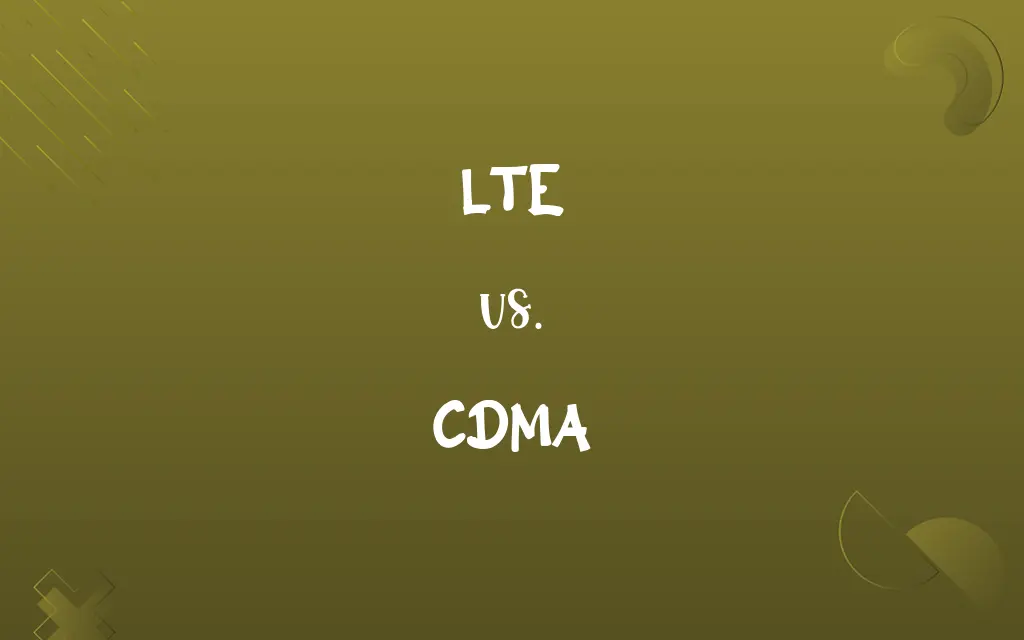LTE vs. CDMA: Know the Difference

By Shumaila Saeed || Published on February 4, 2024
LTE (Long Term Evolution) is a 4G wireless communication standard with high-speed data transfer, while CDMA (Code Division Multiple Access) is an older 2G/3G technology for mobile networks.

Key Differences
LTE, standing for Long Term Evolution, represents the latest advancement in mobile network technology, offering faster data speeds and improved network efficiency. CDMA, or Code Division Multiple Access, is an earlier mobile communication standard, primarily used for voice transmission and slower data services.
Shumaila Saeed
Feb 04, 2024
A key feature of LTE is its ability to support high-definition voice calls and video streaming, thanks to its high bandwidth capabilities. In contrast, CDMA, while reliable for voice calls, lacks the bandwidth to efficiently handle high-speed data and rich media content.
Shumaila Saeed
Feb 04, 2024
LTE operates on a different technology basis, using a simplified all-IP network for both voice and data. CDMA uses a spread-spectrum technology where each conversation is encoded with a unique key, making it secure but less efficient in handling high data volumes.
Shumaila Saeed
Feb 04, 2024
The adoption of LTE has been driven by the growing demand for mobile internet and multimedia services, which require higher speeds and lower latency. CDMA, on the other hand, was more prevalent in the early days of mobile telephony, focusing on optimizing voice communication.
Shumaila Saeed
Feb 04, 2024
Compatibility with global standards is a significant advantage of LTE, facilitating international roaming and wide device compatibility. CDMA, in contrast, has limited global reach, with its usage more confined to specific regions like North America.
Shumaila Saeed
Feb 04, 2024
ADVERTISEMENT
Comparison Chart
Global Compatibility
Broadly compatible internationally
Limited, more regional usage
Shumaila Saeed
Feb 04, 2024
ADVERTISEMENT
LTE and CDMA Definitions
LTE
A 4G wireless broadband technology for high-speed data and media transmission.
LTE has enabled faster internet browsing on my phone.
Shumaila Saeed
Jan 19, 2024
CDMA
A spread-spectrum technology, optimizing the use of available bandwidth.
CDMA efficiently managed multiple conversations simultaneously.
Shumaila Saeed
Jan 19, 2024
LTE
A technology offering increased bandwidth and lower latency in mobile networks.
Streaming movies is seamless thanks to LTE technology.
Shumaila Saeed
Jan 19, 2024
CDMA
Predominantly used in North America and parts of Asia for mobile communication.
CDMA networks were dominant in the United States before the advent of 4G LTE.
Shumaila Saeed
Jan 19, 2024
LTE
LTE supports higher capacity and better network performance than previous generations.
LTE has allowed for the proliferation of mobile apps requiring high data speeds.
Shumaila Saeed
Jan 19, 2024
ADVERTISEMENT
CDMA
CDMA is less suited for high-speed data and multimedia content.
Switching from CDMA to LTE was necessary for better internet access on my phone.
Shumaila Saeed
Jan 19, 2024
LTE
An all-IP network standard, providing efficiency and speed in data handling.
With LTE, I can download large files much quicker than before.
Shumaila Saeed
Jan 19, 2024
CDMA
A 2G/3G mobile technology using unique codes for each conversation.
CDMA technology was integral in the early development of mobile phones.
Shumaila Saeed
Jan 19, 2024
LTE
LTE stands for Long Term Evolution, indicating continuous technological improvement.
The switch to LTE dramatically improved video call quality.
Shumaila Saeed
Jan 19, 2024
CDMA
CDMA stands for Code Division Multiple Access, focusing on secure voice communication.
Our old family phone operated on CDMA and had excellent call quality.
Shumaila Saeed
Jan 19, 2024
Repeatedly Asked Queries
What speeds can LTE offer?
LTE provides high-speed internet, capable of handling HD streaming and fast downloads.
Shumaila Saeed
Feb 04, 2024
What is LTE?
LTE is a 4G wireless communication standard for high-speed data transfer.
Shumaila Saeed
Feb 04, 2024
Is CDMA suitable for internet browsing?
CDMA is slower and less efficient for internet browsing compared to LTE.
Shumaila Saeed
Feb 04, 2024
Can LTE support video calls?
Yes, LTE supports high-definition video calls.
Shumaila Saeed
Feb 04, 2024
Is LTE backward compatible with older mobile networks?
LTE networks are designed to be backward compatible with 2G and 3G technologies.
Shumaila Saeed
Feb 04, 2024
What is CDMA?
CDMA is an older mobile network technology, primarily used for voice communication.
Shumaila Saeed
Feb 04, 2024
Is LTE the same as 5G?
No, LTE and 5G are different generations of wireless technology, with 5G offering even higher speeds and lower latency.
Shumaila Saeed
Feb 04, 2024
Is CDMA still widely used today?
CDMA was widely used in 2G and 3G networks, but it has been largely replaced by LTE and other technologies.
Shumaila Saeed
Feb 04, 2024
Is CDMA more secure than other cellular technologies?
CDMA offers some level of security due to its unique coding scheme, but security depends on the implementation.
Shumaila Saeed
Feb 04, 2024
Did CDMA networks support data services like mobile internet?
Yes, CDMA networks offered data services, but they were less efficient than modern technologies like LTE.
Shumaila Saeed
Feb 04, 2024
What frequency bands are used for LTE?
LTE operates on various frequency bands, including 700 MHz, 800 MHz, 1800 MHz, and more, depending on the region.
Shumaila Saeed
Feb 04, 2024
Can LTE be used for both mobile devices and home internet?
Yes, LTE can provide internet connectivity for both mobile devices and home use.
Shumaila Saeed
Feb 04, 2024
Can CDMA and GSM devices work on the same network?
CDMA and GSM are not compatible, so devices designed for one network typically do not work on the other.
Shumaila Saeed
Feb 04, 2024
Why did CDMA lose popularity in the cellular industry?
CDMA faced competition from GSM and later LTE, which offered more efficient and globally adopted standards.
Shumaila Saeed
Feb 04, 2024
Is CDMA still used in specific applications or regions today?
CDMA is less common in cellular networks but may still be used in specific applications like satellite communication or in certain regions.
Shumaila Saeed
Feb 04, 2024
What is the main advantage of CDMA in terms of call quality?
CDMA typically provides better call quality and reduced interference compared to some other technologies.
Shumaila Saeed
Feb 04, 2024
Share this page
Link for your blog / website
HTML
Link to share via messenger
About Author
Written by
Shumaila SaeedShumaila Saeed, an expert content creator with 6 years of experience, specializes in distilling complex topics into easily digestible comparisons, shining a light on the nuances that both inform and educate readers with clarity and accuracy.






































































